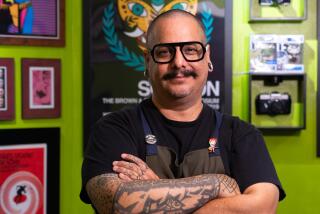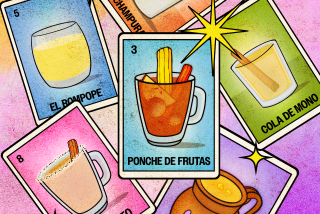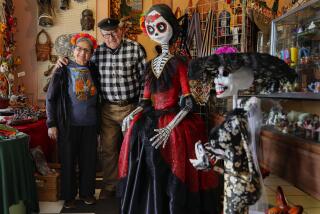No Masking the Work of Puerto Rico Artists
PONCE, Puerto Rico — The small yard outside Juan Alindato’s cozy wooden house is bedecked with finished masks and masks in the making. Every available shrub and tree supports a different papier-mache devil’s head with protruding horns.
The least-completed masks are still the color of brown paper bags. Others have been given a first coating of a primary-color enamel paint. Still others have elaborate multicolor definition on cheeks, forehead and horns.
Standing in the middle of the yard, the 70-year-old Alindato seems pleased to be surrounded by his creations. He calmly and methodically moves from one mask to another, adding a coat of paint here or a detail there, stopping from time to time to chat with friends or clients who drop by to check on his progress.
Alindato learned the art of mask making from his wife’s mother. In turn, he taught the craft to his two sons, who now have established their own ateliers and styles.
Best known is Juan Alindato Jr., now 35, who has been making and selling masks since he was 14.
Juan Alindato and his sons are among several families who have their homes and ateliers in the Ponce seaside neighborhood of Playa de Ponce. Like the other mask makers, the elder Alindato has a regular full-time job--he works on the docks in San Juan--to pay his bills and support his family. But he dedicates almost all of his free time to mask making, his labor of love.
The mask-making process is simple but time-consuming. Brown paper or old newsprint is torn into strips, thoroughly moistened in glue and placed over a greased plaster or wooden mold.
When the basic head is formed and allowed to dry, the eyes, nostrils and sometimes a mouth are cut out.
For Ponce Carnival devils’ masks, elaborate horns that may be two feet long and protruding beak-like lips are shaped separately out of papier-mache and then attached. The masks are then sanded to make them smooth, or they may be left roughly textured for a more traditional style.
They are then painted with enamel in elaborate and colorful designs. It usually takes several days to complete a mask.
The artistry and individual style comes from inventive shaping and painting. Alindato’s masks are characterized by symmetrical horn formations, wide and drooping eyes and grinning mouths with spiked teeth. He does not sand the surfaces before painting the masks with dark green, bright red, blue and yellow high-gloss paint. Juan Jr.’s masks characteristically have dog-like muzzles and horns about four feet long.
This is the busiest time of the year for Juan Alindato and the other mask makers. The devil masks are in demand throughout the year because they are purchased by crafts boutiques in Ponce and San Juan for sale locally and for export to craft stores abroad. But from now through the beginning of the year, the artisans work hard to gear up for their biggest selling season. It begins in January when locals snap up the best masks in anticipation of the festivities surrounding Ponce’s annual Carnival, scheduled next year for Feb. 14-19.
Ponce’s Carnival, a tradition that came to the island with the Spanish conquerors, is Puerto Rico’s answer to Rio’s Carnival. The difference is that in Ponce, revelers parade through the streets wearing devils’ masks to top off their ankle-length robes and costumes.
After Carnival, the local celebrants use the masks as wall decorations. Some households display dozens of masks by several generations of mask makers.
The devil masks are also valued worldwide as collectible Puerto Rican folk art. In order to attract collectors, the artisans produce elaborate masks that feature magnificent horns. They also make miniature masks that are easier to transport home.
Because this is a period of high production, it’s an excellent time to buy, either directly from the artisans or from craft shops that are stocking up for the Carnival season.
Visiting the ateliers is a wonderful experience. Not only can you see how the masks are made, but most of the artists sell directly to customers at prices usually 50% less than those charged in the shops.
You can find Juan Alindato at 18 Calle Puerta Vieja, where he charges about $20 to $80 for his masks. Juan Alindato Jr. has his atelier at Calle 10, house number AB-12, in Villa de Carmen, not far from his father’s house. Juan Jr. charges about $150 to $200.
The masks of Miguel Angel Caraballo (24 Calle San Tomas, near the old beach in Playa de Ponce) often resemble roosters, pigs, horses or other animals adorned with horns. Prices start at $70.
Miguel Angel Perez (10 Calle Arias) makes masks with as many as two dozen snakelike horns. The artist sands the surfaces of his masks, paints them with brooding colors and then dots them with bright, contrasting colors. The masks sell for about $75 to $125.
By comparison, the masks of Egberto Oquendo (20 Calle Jardines) seem unrefined. They are sometimes lumpy and crudely painted, but some have well-constructed movable jaws. Prices range from $10 to $45.
Such ateliers can be hard to find and some of the artists speak little or no English, making it more convenient to buy masks at shops. In Ponce, the shop at the Ponce Museum of Art (on Avenida Las Americas) usually has some excellent masks in stock, priced from about $35 to $120.
An even better selection can be found in San Juan at Puerto Rican Art & Crafts, 204 Fortaleza St., Old San Juan. It stocks a wide range of devil masks, including those made by many of the top Ponce artists. Prices from $5 for miniatures to $400 for multihorn masks.
More to Read
The biggest entertainment stories
Get our big stories about Hollywood, film, television, music, arts, culture and more right in your inbox as soon as they publish.
You may occasionally receive promotional content from the Los Angeles Times.










